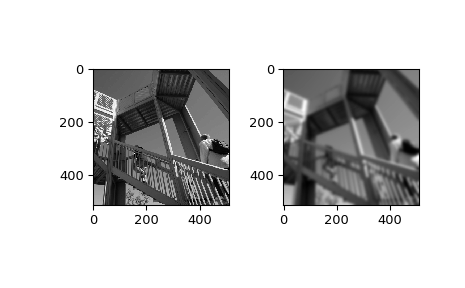scipy.ndimage.gaussian_filter¶
-
scipy.ndimage.gaussian_filter(input, sigma, order=0, output=None, mode='reflect', cval=0.0, truncate=4.0)[source]¶ Multidimensional Gaussian filter.
Parameters: input : array_like
Input array to filter.
sigma : scalar or sequence of scalars
Standard deviation for Gaussian kernel. The standard deviations of the Gaussian filter are given for each axis as a sequence, or as a single number, in which case it is equal for all axes.
order : int or sequence of ints, optional
The order of the filter along each axis is given as a sequence of integers, or as a single number. An order of 0 corresponds to convolution with a Gaussian kernel. A positive order corresponds to convolution with that derivative of a Gaussian.
output : array, optional
The output parameter passes an array in which to store the filter output. Output array should have different name as compared to input array to avoid aliasing errors.
mode : str or sequence, optional
The mode parameter determines how the array borders are handled. Valid modes are {‘reflect’, ‘constant’, ‘nearest’, ‘mirror’, ‘wrap’}. cval is the value used when mode is equal to ‘constant’. A list of modes with length equal to the number of axes can be provided to specify different modes for different axes. Default is ‘reflect’
cval : scalar, optional
Value to fill past edges of input if mode is ‘constant’. Default is 0.0
truncate : float
Truncate the filter at this many standard deviations. Default is 4.0.
Returns: gaussian_filter : ndarray
Returned array of same shape as input.
Notes
The multidimensional filter is implemented as a sequence of one-dimensional convolution filters. The intermediate arrays are stored in the same data type as the output. Therefore, for output types with a limited precision, the results may be imprecise because intermediate results may be stored with insufficient precision.
Examples
>>> from scipy.ndimage import gaussian_filter >>> a = np.arange(50, step=2).reshape((5,5)) >>> a array([[ 0, 2, 4, 6, 8], [10, 12, 14, 16, 18], [20, 22, 24, 26, 28], [30, 32, 34, 36, 38], [40, 42, 44, 46, 48]]) >>> gaussian_filter(a, sigma=1) array([[ 4, 6, 8, 9, 11], [10, 12, 14, 15, 17], [20, 22, 24, 25, 27], [29, 31, 33, 34, 36], [35, 37, 39, 40, 42]])
>>> from scipy import misc >>> import matplotlib.pyplot as plt >>> fig = plt.figure() >>> plt.gray() # show the filtered result in grayscale >>> ax1 = fig.add_subplot(121) # left side >>> ax2 = fig.add_subplot(122) # right side >>> ascent = misc.ascent() >>> result = gaussian_filter(ascent, sigma=5) >>> ax1.imshow(ascent) >>> ax2.imshow(result) >>> plt.show()

